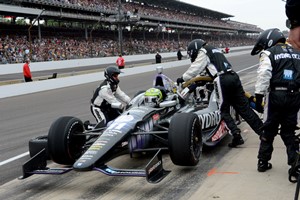EMBARGOED FOR RELEASE | September 09, 2013
INDY 500 race cars showcase green fuels
Note to journalists: Please report that this research was presented at a meeting of the American Chemical Society.
A press conference on this topic will be held Sunday, Sept. 8, at 4:30 p.m. in the ACS Press Center, Room 211, in the Indiana Convention Center. Reporters can attend in person or access live audio and video of the event and ask questions at www.ustream.tv/channel/acslive.
INDIANAPOLIS, Sept. 9, 2013 — Mention cars that get barely 3 miles to a gallon and are built for speed rather than cleanliness, and images of gas-guzzling, pollution-belching environmental menaces burning leaded gasoline or nitro may spring to mind. But experts at a major scientific meeting today described how ethanol blends used as fuel in the race cars of the Indianapolis 500 actually make those emissions cleaner than cars on the street.
They spoke at a symposium entitled “The Chemistry of Racing,” part of the 246th National Meeting & Exposition of the American Chemical Society (ACS), the world’s largest scientific society. The meeting, which features almost 7,000 presentations on new discoveries in science and other topics, continues here through Thursday in the Indiana Convention Center and downtown hotels.
Indresh Mathur, Ph.D., who gave one of the talks, explained that cars on streets and highways in the U.S. run on a mixture of 90 percent unleaded gasoline and 10 percent ethanol. Race cars in the Indianapolis 500 burn mostly fuel-grade ethanol. This year the Indy 500 switched to a fuel containing 85 percent ethanol as opposed to 100 percent fuel ethanol. This makes the Indy fuel close to the real-life E-85 fuel sold at some U.S. gas stations.
“Fueled with mostly ethanol, these race cars burn more fuel cleanly and release mainly carbon dioxide and water vapor into the air,” said Mathur. “Even without the catalytic mufflers, there are much lower emissions of air pollutants that can have adverse effects on human health and promote the formation of smog.”
Mathur, who is with Johann Haltermann Ltd., in Houston, said those include PAHs –– polycyclic aromatic compounds that exist naturally in the crude oil that becomes gasoline have been largely responsible for particulate matter emissions. The Indy fuel blend of E-85 sets a good example of the use of an alternative fuel use under very demanding engine conditions. It is a fertile ground for engineers to perfect the E-85 vehicle technology that can be leveraged into street vehicles.
Studies have shown that using fuels composed of more than 85 percent ethanol reduce a variety of air pollutants. These include sulfur emissions (80 percent lower), carbon monoxide (40 percent), particulate matter (20 percent), VOCs (15 percent) and nitrogen oxides (10 percent).
Timothy Ruppel, a fuel expert at PerkinElmer in Oak Brook, Ill., described testing procedures to ensure that every truckload of racing fuel delivered to the track has the same chemical composition. For the Indy 500, Ruppel said, nearly 100 samples are tested for the first two weekends of qualifications, and the top 12 finishers are tested after the race is over.
Motor oil, which can have a significant impact on a car’s operformance, also undergoes tests to ensure that it meets track specifications.
“Some racing fuels today still use lead compounds for boosting the octane rating of the fuel,” said Mathur. “No lead is allowed in street fuel. By contrast, the racing fuel can be leaded and may vary according to the requirements of the race sponsoring authority. For environmental reasons, this lead should be eliminated. Perhaps there should be more diesel-fueled racing cars and racing cars fueled by renewable and ‘green’ fuels.”
To automatically receive news releases from the American Chemical Society, contact newsroom@acs.org.
# # #
The American Chemical Society is a nonprofit organization chartered by the U.S. Congress. With more than 163,000 members, ACS is the world's largest scientific society and a global leader in providing access to chemistry-related research through its multiple databases, peer-reviewed journals and scientific conferences. Its main offices are in Washington, D.C., and Columbus, Ohio.
Media Contact
During the national meeting, Sept. 6-11, the contacts can be reached at 317-262-5907.
Michael Bernstein
m_bernstein@acs.org
202-872-6042
Michael Woods
m_woods@acs.org
202-872-6293
High-resolution image






